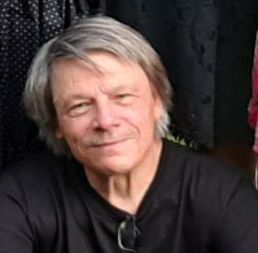Part 2: The old paradigms are questioned
The properties of space
Heisenberg believed
that if a particle moved a very short distance between points A and B, it
would “jump” without using the space in between. That was about 90 years
ago, his idea was way ahead of its time. Even today there are only a few
physicists who dare to follow the consequences by QD
(quantum dynamics). If a particle would glide, it would mean to move in
infinitely small distances. In terms of propagation, these space-elements
would be infinitely small, what means in QD unimaginable energies. The
following applies: the smaller the distance, the greater the force by the
same momentum. Space cannot
consist of infinitely small stretches, it must have an elementary
size.
Space would be rigid and without any "degree of
freedom" (according to Feynman). Such a state would be considered a
singularity, but in reality it is never reached. In order to enable
degrees of freedom, the term elasticity is necessary, a
bending potential that allows deformation and its resistance. Only this
elasticity enables the pulse, a form of energy that acts per frequency
and multiplies to energy with E = hF, where
h = Planck's constant and F = frequency.
Puls p =
E/c = hF/c = (h·c/ʎ)/c =
h/ʎ. p=h/ʎ and so it
derives h=p·ʎ
h=p·ʎ
The heartbeat of our world is a
pulsing momentum (h)
it is invariant and has an universal size
Since h is invariable, only wavelength λ and frequency F can change in space cells. Since λ•F=c (speed of light), λ and F are coherent. Since λ can only have quantities that depend on the scale of the Matrix, F is quantized (ΔF = F1-F2) and therefore only has integer values. In the scales of our everyday physics, however, F appears to be analogous, this no longer applies in the size of the atomic / subatomic world.
The length of edges of tetrahedron and octahedron are in this case the wavelength λ, whereby the frequency of these space cells is also fixed because of F=E/h. If one considers the space cell of a proton as a reference for the smallest part of space, then space, if still to be isotropic, would only have to have an all-encompassing frequency what doesn't make sense. When mapping this space structure via the physical values of particles such as protons, electrons, neutrons and neutrinos, an isotropic view of space can no longer be maintained. The edge length (wavelength λ) S1 (scale 1, size of a proton field) as an isotropic unit of length must be replaced by the rod length (λ) or (distances of field strengths E=h/λ or E=h•F/c) as coherent values of frequency F and field strength E.
Rod length or field distances as quantized scale of fields
For geometric reasons (look in wavelength of space) the bar sizes or λ must keep the ratio of 3^x or 3^-x to each other. These allow frequencies and neighboring relationships to the adjacent colors (or parities of its oscillations) to be retained in the same way and form units in equilibrium again. The nesting fields in a Babushka fashion of octahedra requires a certain ratio of their sizes, which is referred to below as. Nesting means unequal fields with the same center. The ratio of their sizes are:
< < < 3^-4 ; 3^-3 ; 3^-2 ; 3^-1 ; 3^0 ; 3^1 ; 3^2 ; 3^3 ; 3^4 > > >
Here is S1 (3^0); S^3 (3^1); S9=(3^2); S27=(3^3) etc. As was shown
in the Matrix part 1, energies in equilibrium can only use rod length
S1; S3; S5 etc to be observed. It becomes clear that fields mentioned
here as “standing” or “local” fields can only have a
λ (bar length) of odd numbers.
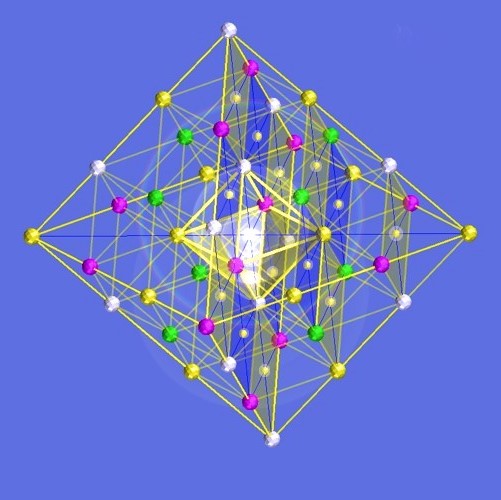 The
frequencies oscillate in the same ratio as the frequency of tone C to tone G to tone G' etc.
As we can see later when looking at particle interactions, the energy
differences
are always one quantum. It should be noted that only the
quantities of field scales 3^x or 3^-x (3^2; 3^3; 3^4 etc.) have the same
center point to each other. This insight becomes important when considering
particles. Several field sizes are formed around the center of particle in
Babushka style. The geometric metric of the nesting fields is important so
that different impulses of fields cancel each other harmoniously.
The
frequencies oscillate in the same ratio as the frequency of tone C to tone G to tone G' etc.
As we can see later when looking at particle interactions, the energy
differences
are always one quantum. It should be noted that only the
quantities of field scales 3^x or 3^-x (3^2; 3^3; 3^4 etc.) have the same
center point to each other. This insight becomes important when considering
particles. Several field sizes are formed around the center of particle in
Babushka style. The geometric metric of the nesting fields is important so
that different impulses of fields cancel each other harmoniously.
Structure and harmony of space
The generally accepted standard model of physics SM assumes that there is a chaotic state of virtual particles in the form of bosons at the deepest (zero point) energy level of space. The “pop-ups” go in two directions as particles and antiparticles. The reason for this state is similar to the matrix, only chaotic. According to this fact an attempt is made to think further with probabilities (simular like the Schrödinger field whose value at any spatial point is the probability for an interaction at that point). On the one hand, this model gives the researcher more space for interpretations of his experiments; on the other hand, he cannot hold on anywhere in this jungle of possibilities.
It is different in the Matrix of space. There, the pop-ups are bind together in such a way that they form again units of equilibrium, which create structures (a Matrix) in certain scales. The main reason for this much more reasonable behavior comes from the fact that the current state of space we have found, is the result of extreme compression during a so-called "Big Bang" situation. The cosmological conditions are in this way still included to the Matrix at the smallest possible way. The basic state of space does not start all over again from the first sketch but is the consequence of its past.
Quantendynamic deforming of space
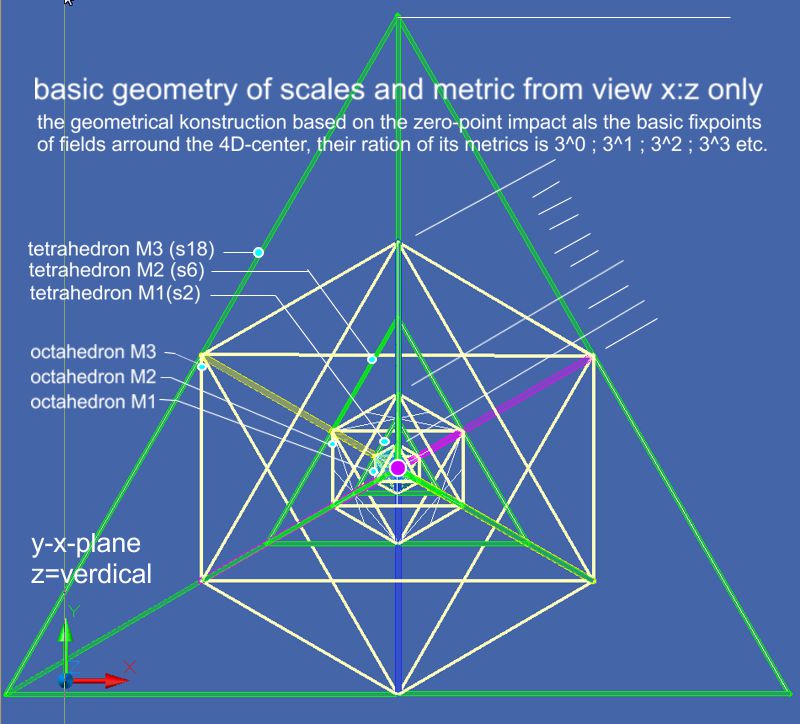
The Matrix sees particles as standing waves. They therefore have a frequency. They are no longer particle as solid balls, but because ot their high frequency, they appear as particle.
Today we know since Einstein that in principle "empty space" has no
medium in physicle terms. But an empty space would result in a way, that
interactions of particles (as standing waves) have to transmitt bosons or photons.
This of course is a contradiction in terms. This particle zoo, however,
can´t replace a medium, they also need a medium them self.
It is the weak point of Einstein´s space.
The
solution seemed to be the idea of
a plasma soup of virtual particles creating something like an energy level. Since
Planck's formula E=hF connects
the energy with pulses and frequency, it can be concluded that such a medium
always has an associated frequency. Frequency F=c/λ
requires that the medium must consist of a certain wavelength, in the Matrix
it would be our rod
length of its scale.
 An
important, yes axiomatic point is the existence of standing waves.
The Matrix Theory sees the reason in the 4D double oscillation. It is the
local oscillation of a field that arises from an oscillation with a tensor
(vector) from the invisible 4th dimension.
An
important, yes axiomatic point is the existence of standing waves.
The Matrix Theory sees the reason in the 4D double oscillation. It is the
local oscillation of a field that arises from an oscillation with a tensor
(vector) from the invisible 4th dimension.
You can imagine a string (1
dimensional) on a guitar where the vibration in a resonance body (2
dimensional) vibrates at right angles to the string. The matrix structure of
space shows us that the standing waves (local fields) always lie in the
scale ranges of odd numbers (S1; S3; S5; etc.), while the waves traveling or
propagating with V=c (light ) are in the range of even scales.
Oscillation instead of a rigid space
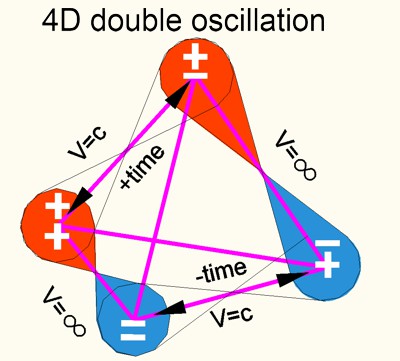
Rigid
space is crystalline. It doesn´t represents time. An oscillation instead a
distance makes space to a living space-time but has 4 dimensions. An
oscillation always forms a 180° cycle. A whole cycle of 360° therefore has
at least 2 parities. A double oscillation has 4 parities and is able to
represent 4 dimension.
In the picture at the left, a double oscillation
is shown by only one 360° cycle. It has 2 double-parities with 2 values each
parity.
This creates 4 states or parities here:
(++)=red,
(+-)=green, (-+)=yellow,
(- -)=blue.
The pictur shoes red (+) time and blue (-) time. They could also be seen as 4 colors of the Matrix space. The meaning of this consideration is that with the completed cycle this unit adds energetically to zero and, as a medium-space atom, can also be a unit of “empty space”. As a unit, it has the shape of a tetrahedron. Since this has the same rod length (λ), the unit also has the frequency c/λ. 4 parities are generated here, which add up to zero when interacting with neighboring units. In this way they represent the "empty space".
Parity or charge
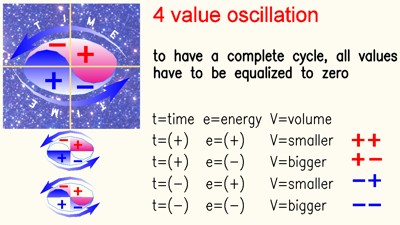 The
standard model of physics requires the criterion of charge
(+) and (-) for the above-mentioned interaction. This is replaced by the
MFT (matrix-field theory) by the term parity,
since MFT regards all particles as oscillation, which means a change from
(+) and (-). This is difficult to understand and requires to give up the
idea of empty space with the mechanics of separate particles. In the MFT, a particle
is a distortion of space and time. Therefore a particle
oscillation is always in the same rhythm as its medium, here at the location
(x; y: z: t) where t (time) is the oscillation tensor toward the 4th spatiel dimension. A particle is therefore not simply (+) or (-) but has a
parity at this location (x; y; z; t) as a status of its oscillation (++) or
(+-) or (-+) or (- -). The MFT sees it as 2 oscillations at right angles to
each other. One as a compression / depression of 3D space and the other as
(+) / (-) time (as a tensor to the 4th spatial dimension), which requires
its antiparts (antimatter) in addition to the particle or space atom. This
dynamic of space is seen in the SM (Standard Model) as either particles or
antiparticles with (+) or (-) charges.It's the Dirac equation.
The
standard model of physics requires the criterion of charge
(+) and (-) for the above-mentioned interaction. This is replaced by the
MFT (matrix-field theory) by the term parity,
since MFT regards all particles as oscillation, which means a change from
(+) and (-). This is difficult to understand and requires to give up the
idea of empty space with the mechanics of separate particles. In the MFT, a particle
is a distortion of space and time. Therefore a particle
oscillation is always in the same rhythm as its medium, here at the location
(x; y: z: t) where t (time) is the oscillation tensor toward the 4th spatiel dimension. A particle is therefore not simply (+) or (-) but has a
parity at this location (x; y; z; t) as a status of its oscillation (++) or
(+-) or (-+) or (- -). The MFT sees it as 2 oscillations at right angles to
each other. One as a compression / depression of 3D space and the other as
(+) / (-) time (as a tensor to the 4th spatial dimension), which requires
its antiparts (antimatter) in addition to the particle or space atom. This
dynamic of space is seen in the SM (Standard Model) as either particles or
antiparticles with (+) or (-) charges.It's the Dirac equation.
They are the Dirac-Spinors
Because contemporary physics, despite Dirac's mathematical proof, still clings to the notion of separate particles in a separate (and therefore empty) space, a separate antiparticle was invented by Dirac, which he (reluctantly) offered as a solution (and got the Nobel Prize). The MFT only sees a particle in 4 states. It is solely the geometry of the matrix. However, it is the same particle, but measured from our side of (+) time) to a (-) time parity.
The reason for this blindness of today's physics is that the matrix allows
all scaled fields (from the proton to the EM field and larger) to oscillate
synchronously in time.
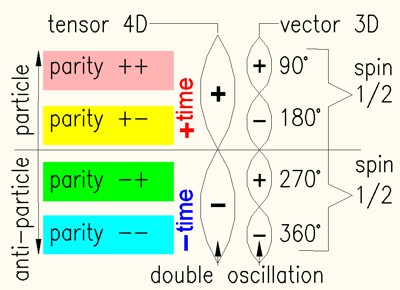 All
parities in (-) time
All
parities in (-) time
((-+) (- -)) are asynchronous to the gauge.
Therefore only the vibrations (++) (+-)
are measured. This only
applies to particles smaller than neutrinos, since all larger fields
interact with photons (3-D fields). Photons are moments added to the
parity of their medium. The perturbation of space is then taken as parities
(+) and (-).
Left: 3D-parities (0°-90°), (90°-180°) are
Push/Pulls in (+) time period, (180°-270°), (270°-360°)are push/pull in the
(-) time period. They are acknowledged as 1/2 SPIN periods. Under the
influence of (+) and (-) time, the 4 parities of the double oscillation are
symbolized here as 4 colors. In contrast to Dirac, the MFT
only recognizes the spin as a time cycle, not as an orbit.
Charge: a new concept of space is aplied
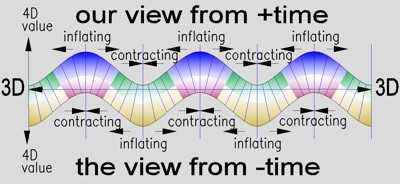 The
picture here shows a section through the 3D- surface which is the 3D space in the 4D
space concept and therefore has a top and bottom side. The wave-like
deformation (oscillation) creates a pull-push on the top (+time) and
push-pull on the bottom (-time) in a 360° cycle.
The
picture here shows a section through the 3D- surface which is the 3D space in the 4D
space concept and therefore has a top and bottom side. The wave-like
deformation (oscillation) creates a pull-push on the top (+time) and
push-pull on the bottom (-time) in a 360° cycle.
The 4
· 90° cycle is represented by 4 colors
(++)=Blau
(+-)=Grün (-+)=Gelb
(- -)=Violett
This is the +/- time oscillation in the scheme above and is difficult to understand. Oscillation as a single event would have no relevance for physics. It would not be detectable for us in the period ʎ/c. Visibility in the scale of our devices are based on repetition only. But here Oscillation creates 2 views where only one is invisible for our gauge. However, the perspectives always create a relationship to the adjacing space and its parities. In this way, apparently static spatial structures are formed, which, however, build of repetition effect. Physics calls this a virtual state, but only limits it to a "zero-state" plasma. However, it is a universal principle for all particles and fields.
With the designation electron = e(x;y;z) or proton = p(x;y;z) the time value of parity(x;y:z:t) in SM (Standard Model) is missing in today's physics. Theoretically, this should be named as (+) or (-). But since in SM a particle has (+) or (-) charge as a static property, the time parity is no longer needed in SM. The Matrix theory does not want to introduce any new rules, it only intended to give background information. No matter where the interaction of a particle is, it has everywhere e.g. at location (x1;y1;z1;t1) the parity of electron = e(x1;y1;z1;t1). Instead of saying: the electron is (-), we now say electron = e(x;y;z;t) and mean (+) or (-), in any case the opposite parity to a proton. Both are (+) or (-) according their location, but react always as opposite parities. Particles have no electric charge but the value (t) of the location x;y;z;t. Particles don't have a spin with a chirality, they have the parity x;y;z;t. It's an effect of the Matrix of space.
Protons always have opposite parities of electrons at the space-point of interaction.
A neutron has a double parity with zero result and does not culminate in the energy field range of the electron-proton interaction. Ultimately, this means that it only has an equal interaction in the more compressed field area (gluons). It is a requirement of the matrix space dynamic .
Each particle oscillation is coherent with
the space oscillation.
It has to
be noted, that charge in the SM is not connected to space and only a property
of the particle. Parity needs a structural space and is a property of
it, therefore particle are space locations. That is why particle are not
separated from space, they are properties of it.
Attraction / compelling as a parity of oscillation
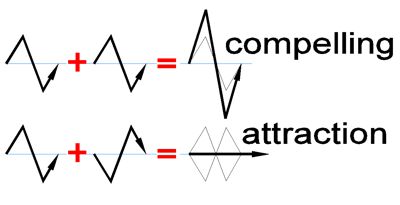 In 4D matrix space there are basically 2 effects of spatial deformation.
The 4D spatial deformation culminates (gravity) and the 3D spatial
deformation seeks balance. Here reference is made to balancing the 3D space.
Prerequisite is a medium and a structural order of its inner space network.
In 4D matrix space there are basically 2 effects of spatial deformation.
The 4D spatial deformation culminates (gravity) and the 3D spatial
deformation seeks balance. Here reference is made to balancing the 3D space.
Prerequisite is a medium and a structural order of its inner space network.
It is a
simple principle of a structured 4D matrix space. The prerequisite is a medium
and a structural order of its inner space network. If the distances between
nodes are strongly bent, then there is a contraction in space network
(called here as compression). This is only possible if the elasticity of the
network results in decompression areas (zones where the network is in
tension) around the contraction field. These in turn tend to cancel out or
compensate for each other with compressed network areas. If that were the
only truth, our world would soon have disappeared and everything would have
the value of zero. However, the compensation has a complicated structure. If
there are distortions in 3D space, then they immediately compensate each
other with V=c. If there are
distortions with a vector at 4D-space, the compensation will be limited
to a quantum (e = hf) within a distance (or scale S1-Sx). In the surrounding
3D space, the balance becomes visible through an overriding tendency to
approach the possible place of balance (attraction). The opposite will be
the case when the balance sheet is a culmination, i.e. the opposite of what
would produce a rejection. The picture below shows the dynamics of the basis
without the superordinate effect of a quantum dynamic compensation. Space is
not empty, it has an entropic pressure.
So it doesn't depend on (+) or (-) but only on - equal or unequal -
The scenario + or - as a charge or peculiarities of the particles only arises by the property of 3D space to balance all distortions. However, this compensation is limited to the certain rod length of the relevant scale ( the field size λ=hc/e). So it is an overriding property of the space to balance out itself. This property allows a momentum in the limited field area to be drawn towards the counter momentum. An attraction is created. Only this brings a flattening (depression) of space by attraction, by interaction with the counter-moment or counter-parity. It is irritating that a depression of space means attraction. This is just the effect of the overlying tendency become an equilibrium.
If there were only + or - for repulsion or attraction in physics, then nothing would prevent the particles of our world from either merging or radiating to the edge of the universe. With the field structure (or matrix geometry) the interactions always result in wave-like peaks and valleys, where the interaction each time climbs a peak to fall into an even deeper valley, then climbs an even steeper peak and falls into an even deeper valley, until it found a permanent place there.
All constellations are the balance of all the participated components.
The Matrix-Field-Dynamic
Fields in Matrix theory have defined shapes at 0° Kelvin, but they become deformed depending on the status of space. Since space is also a medium and oscillates in this function, everything has a movement. It is the fabric where space and time are woven in.
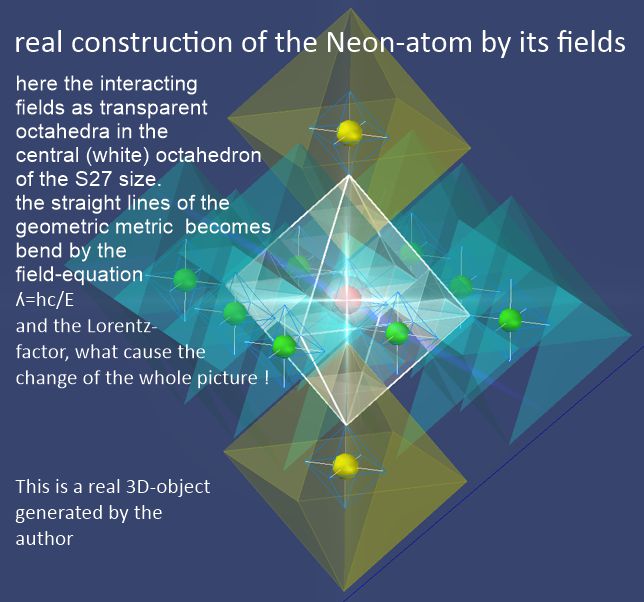
Even today, experimental physics has nothing useful for describing field dynamics. Here the attempt is made to represent the principle of fields in the atomic shell around the nucleus despite the all-encompassing oscillations of space at unattainable frequencies (F=h/c).
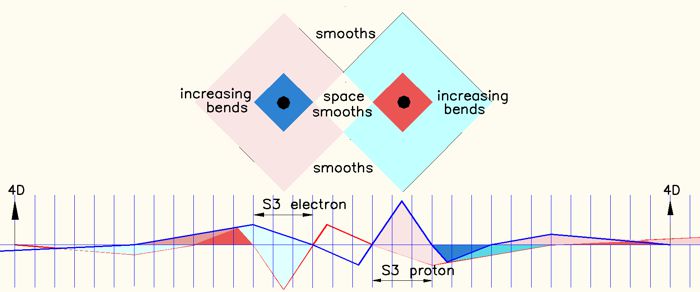
The fields shown here are assumed to have (-) and (+) parities of their oscillation. An assignment to electrons/protons is not a criterion here. The principle of field overlapping alone will be presented here. It is assumed that a +/- overlap causes a smoothing of space and thus attracts the steeper field areas.
The new concept of time
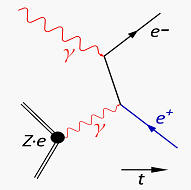 Einstein's
theory of relativity (proven x times) says: Space and time is a continuum by
zero = (tc)^2)-(x^2)-(y^2)-(z^2), where tc=time•lightspeed is. Every
distance is therefore also time. Distance in 4D = √(x^2+y^2+z^2+(tc)^2). But only at
the speed of light V=c. Since then tc=0, the question of the nature of time
remains open. Since Feynmann, who interpreted the QD in his
diagrams, a declining time had to be expected (e.g. pairing of (-) and (+)
electrons). Although a causality no longer seemed possible, this continued to
be applied out of convenience. In the Matrix, time is a 4th dimensional
effect. As already described above, from the point of view of the 4th
dimension, our space is the surface of a hyper sphere, the "title wave" from
the 4D center, the big bang. Seen in this way, particles have a front and
back side as a 4D oscillation, an oscillation from (-) time to (+) time.
Time is therefore the radial movement fluctuation from the 4th dimension. It
is the oscillation perpendicular to 3D space that creates the "standing
waves" of fermions.
Einstein's
theory of relativity (proven x times) says: Space and time is a continuum by
zero = (tc)^2)-(x^2)-(y^2)-(z^2), where tc=time•lightspeed is. Every
distance is therefore also time. Distance in 4D = √(x^2+y^2+z^2+(tc)^2). But only at
the speed of light V=c. Since then tc=0, the question of the nature of time
remains open. Since Feynmann, who interpreted the QD in his
diagrams, a declining time had to be expected (e.g. pairing of (-) and (+)
electrons). Although a causality no longer seemed possible, this continued to
be applied out of convenience. In the Matrix, time is a 4th dimensional
effect. As already described above, from the point of view of the 4th
dimension, our space is the surface of a hyper sphere, the "title wave" from
the 4D center, the big bang. Seen in this way, particles have a front and
back side as a 4D oscillation, an oscillation from (-) time to (+) time.
Time is therefore the radial movement fluctuation from the 4th dimension. It
is the oscillation perpendicular to 3D space that creates the "standing
waves" of fermions.
SUSY the Super Symmetry
The 4-dimensional hyperspace can be imagined at best if
one of the coordinates, here the z-coordinate, is suppressed.
 You
symbolize the 3D space as a 2D image, tilt it until it becomes a line.
You
symbolize the 3D space as a 2D image, tilt it until it becomes a line.
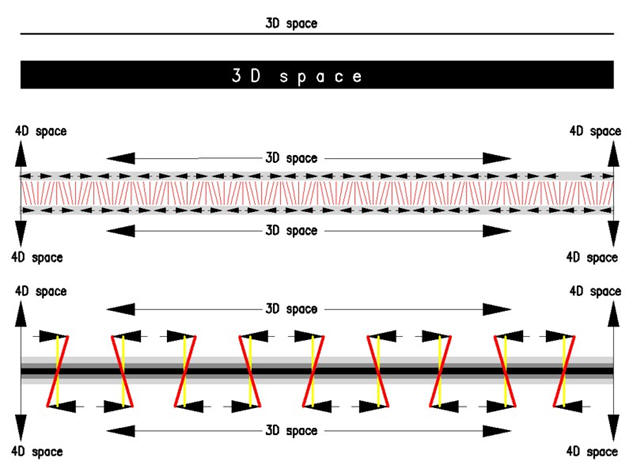 Then
one imagines the line with a very thin thickness, according to the
conditions as a shadow of a higher dimension. In this thickness, we
introduce the processes that describes it as a shadow of the 4th
spatial dimension. Here we see the compression and decompression areas
generalized as tensors of the 4 spatial coordinates of the 4D space.
Then
one imagines the line with a very thin thickness, according to the
conditions as a shadow of a higher dimension. In this thickness, we
introduce the processes that describes it as a shadow of the 4th
spatial dimension. Here we see the compression and decompression areas
generalized as tensors of the 4 spatial coordinates of the 4D space.
The picture below shows the compression and decompression areas as a
wavy line in 3D space. The space can no longer be isotropic here. It is
fractionated into quanta of size E=hF. These
quanta are the basic elements of a 3D spatial structure in form of
tetrahedra. The illustration shows the 4 colors blue-green-yellow-red, which
indicate the 4 possible states (+ +) (+ -) (- +) (- -). This is the double
oscillation. The time here is up (+) time and down (-) time of
the 4-dimensional space.

These 2 sides as shadows of hyperspace are here (above) the normal space symmetry and (below) the SUSI referred to as super symmetry. It is the carrier of antimatter. It becomes clear here that a particle that is explained as a 4D field must have its antiparticle on the opposite side of the 4D space as an inseparable part of its oscillation. Aging of particle cannot take place. Attempts to determine the decay time of Protons came to the conclusion that these particles must live longer than the age of the universe, whatever that means in detail.
Conclusion
Here in Part 2 the structure and dynamics of space have been described to such an extent that a closer examination of particles as "children of space" is now from a completely different point of view possible than from observations of recognized physics, that was generated from empirical research. Space lost its homogeneous character, its image was rounded off with the opposite side (anti-space). Time and pulses were described with a 360 ° cycle. By considering the Planck constant as the momenta of p·ʎ our world, an underlying frequency and wavelength λ is requested. With this, our world was quantized. The old ideas of Euclidean space are replaced with the matrix of space. All of this creates a completely different starting point for considering the QD of particles, which will be discussed in Part 3.
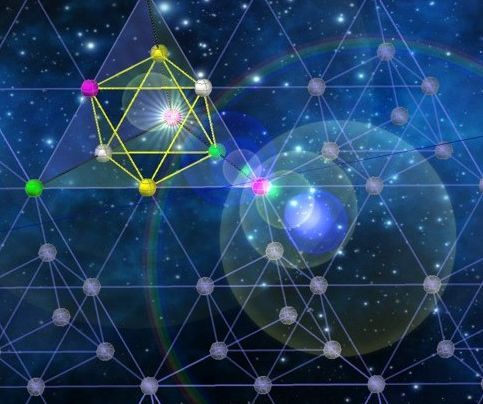
Science sometimes becomes religion when the network of theories becomes dialectic. Knowledge then becomes a fixed building with foundations of which can't be tampered with. But true knowledge is never static and always in motion. Outside the dogma; free Platonic thinking prevails.
Gunter Michaelis, Griesbach, the 20.8.2020
